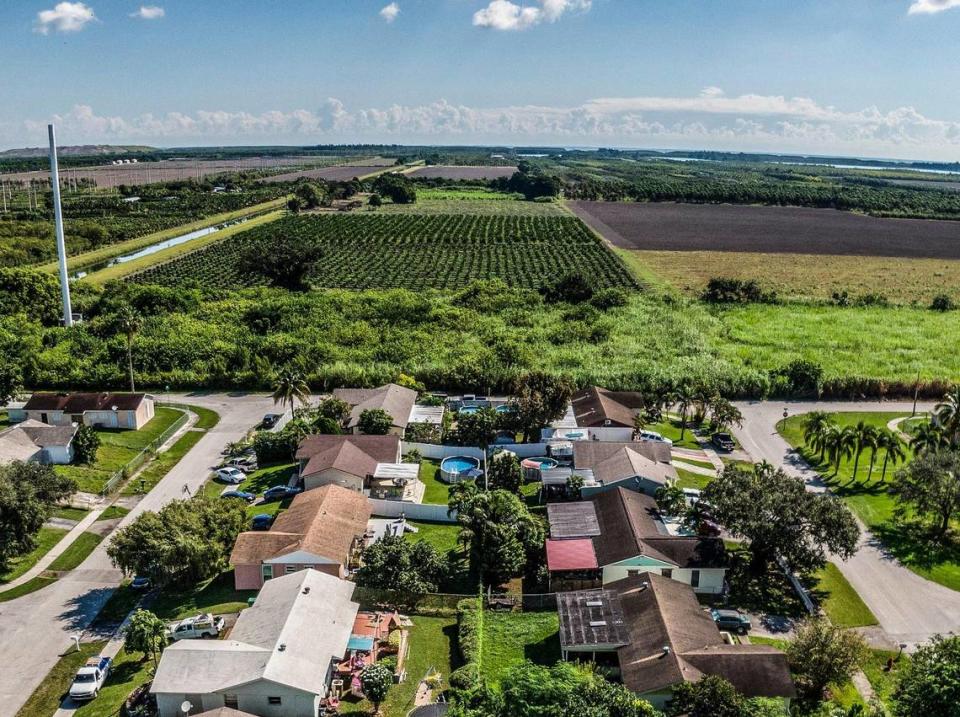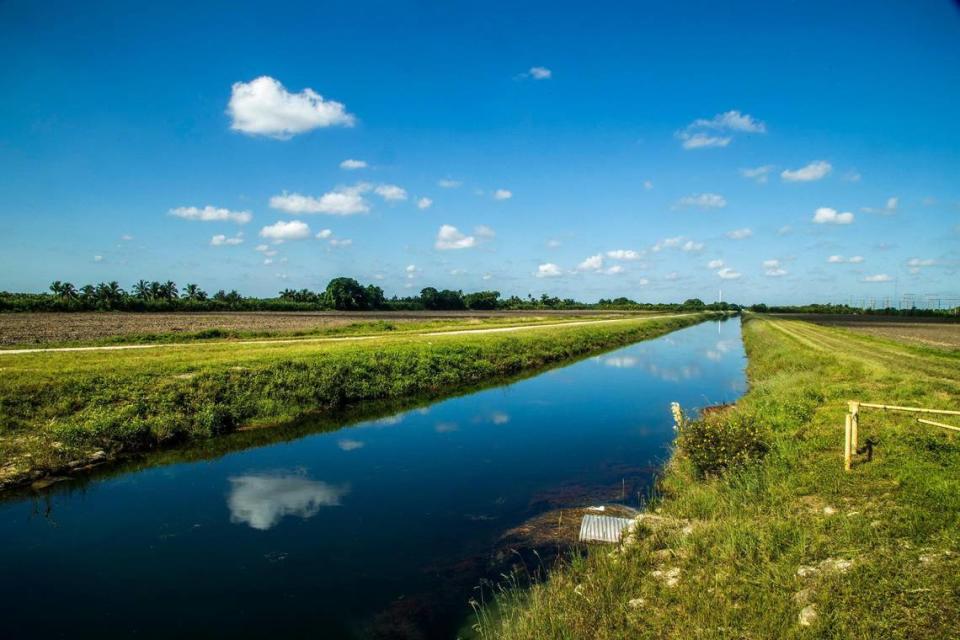Tree farm or warehouses: Which is better for Biscayne Bay? The answers may surprise you
It might seem like an easy question. What’s better for the environment, a tree farm or a crop of warehouses?
But with a massive development and an unprecedented expansion of Miami-Dade’s urban development boundary on the line, that question has developers and environmentalists going toe-to-toe, each armed with dozens of pages of studies and research backing their preferred outcomes.
And on the eve of a final vote by the Miami-Dade County Commission on Thursday, the federal government also has weighed in against it, saying it could affect Everglades restoration efforts.
At issue is an 800-acre property south of the Florida Turnpike extension where farmers grow palm trees and sweet corn. Aligned Real Estate Holdings wants to turn it into the South Dade Logistics & Technology District and build warehouses, shops and a small hotel, which it says will create thousands of much-needed jobs.
There are hurdles: The would-be industrial zone is outside of the urban development boundary, commonly known as the UDB, a regulatory line designed to both control urban sprawl and protect rural and wild lands. The county hasn’t agreed to move the line since 2013.
The tract is also in one of the most vulnerable spots in the county to hurricane-driven storm surge and flooding, which will both be worsened by the two feet of sea level rise expected by 2060. The county’s own development plan — and its staffers — say that building there is a bad idea.
What’s the Urban Development Boundary, and what does it mean for Miami-Dade County?
Despite a resounding “no” from county staffers, Miami-Dade commissioners already moved forward with initial approval of the project last fall, and it’s now up for a final vote on Thursday.
Environmentalists argue that green space is precious and can be used to control flooding and clean water — or potentially be part of future Everglades Restoration projects. They also see it as a test of the county’s commitment to preparing for climate change.
“It’s a real litmus test for the future of Miami-Dade County. Is Miami-Dade County going to take the proactive steps and make the wise decisions that will be necessary to avoid the worst impacts of sea level rise and climate change? We’ll find out on Thursday,” said Eve Samples, director of Friends of the Everglades.
Water quality friend or foe
When considering the environmental impact of switching 800 acres of farmland to a paved warehouse and retail center, the key may lie in how it would affect water quality.
Currently, the property is mostly a palm tree farm, with a couple hundred acres of sweet corn. It’s been farmland for decades, so the soil is packed full of the usual suspects left behind after years of agriculture — heavy metals, pesticides and herbicides.
When it rains, water picks up leftover fertilizer and the contaminated soil and flows into the C-102 canal snaking through the middle of the property. That pollution flushes into Biscayne Bay, which is struggling with sea grass die-offs and fish kills, caused in part by this kind of agricultural runoff.

Ed Swakon, an environmental consultant for the project and president of EAS Engineering, said the development would instead collect that rainwater, run it through a grassy ditch or pond and then drain it back into the aquifer, helping recharge the freshwater supply. Based on modeling using the South Florida Water Management District’s calculations, he said the development would lead to a 74% decrease in pollution of phosphorus and nitrogen.
“This project will help water quality,” he said. “It may not be the conventional way that you would do it.
“You’re not gonna save the bay by building an industrial facility at every location,” Swakon said, but at this site he argues that converting from agricultural use will benefit Biscayne Bay
Opponents of the project say simply reducing fertilizer runoff isn’t the only impact.
Miami-Dade’s Chief Resilience Officer James Murley noted in a letter that urban areas and parking lots come with their own pollution, like heavy metals from tires, brakes and engine wear and oil and fuel drips from cars. Since it’s not clear exactly what businesses would operate in the new development, Murley concluded it was impossible to determine how much pollution they might emit.
The push for more houses in Miami-Dade hits a wall over saving farms outside the suburbs
“The level of information provided to date, would not support the assertion that the health of Biscayne Bay would improve,” he concluded.
The Hold the Line Coalition, a group that advocates keeping the development boundary where it is, also questioned whether the project would help or harm the bay. The coalition outlined its critiques in an 80-plus-page report compiled with a half dozen university professors and expert researchers, which touched on everything from the developer’s job numbers to the impact on nearby endangered species.
Samples said “it flies in the face of common sense” to imagine that paving over Miami-Dade’s vanishing supply of green space would ever be an improvement for the environment.
“The bigger picture is there’s no question that nine million square feet of industrial space would be worse for the bay than agriculture,” she said. “It’s not a sound argument and the technical report has born it out.”
A part of Everglades restoration?
There’s another boundary question about this property that has nothing to do with the UDB.
When developers first announced plans to redevelop the area, environmentalists also were quick to point out that part of the property had been included in early federal plans to restore the Everglades in that area and it remains under consideration for ones still in the works.
The Biscayne Bay and Southeastern Everglades Ecosystem Restoration project, a component of the broader Everglades Restoration plan, kicked off in 2020 with the goal to send more water to Biscayne Bay and restore wetlands and mangroves along the coast. Last fall, four of 10 potential proposals to revive the region envisioned including at least part of the tract for water storage.

In March, scientists narrowed down to three of those plans for further study, none including the tract. But Erica Skolte, a spokesperson for the U.S. Army Corps of Engineers, said that the other, older plans are still part of the process and haven’t been screened out.
In a letter sent Tuesday, the Department of the Interior told the Miami-Dade County Commission it had “concerns” about the impact of this development on future environmental projects in the area.
“Holding the UDB on this application helps maintain the diversity of land uses in the region ... while simultaneously supporting Everglades restoration,” wrote Adam Gelber, director of the office of Everglades restoration initiatives.
Swakon, the environmental consultant for the development, called the idea of using the tract in Everglades restoration “problematic and not likely to occur” in a report on the subject. He also warned if the government wanted to buy the land from unwilling private owners, “the cost of acquiring the property would be prohibitive.
With UDB vote, Miami-Dade shows how hard it is to stop developing in flood-prone spots
Swakon argued that the development would meet the same goals as Everglades restoration — cleaner water — faster and without using taxpayer money.
Despite the concerns raised by the county and Interior, Swakon downplayed the possibility that the land would be targeted for restoration projects, saying a decision won’t even be made until at least August 2024.
“The Corps, anybody can study and draw bubble diagrams on all kinds of properties but that doesn’t mean anything at the end of the day,” Swakon told the Herald. “The likelihood of the project being incorporated into BBSEER is so remote I just don’t think it’s in the cards.”
Everglades advocates don’t see it that way.
The Army Corps of Engineers is still years away from determining which coastal projects it will fund to improve Biscayne Bay, and experts say every inch of wetland and green space counts.
To Samples, with Friends of the Everglades, approving the warehouses now would limit the options for reviving Biscayne Bay — and possibly increase the costs of future projects.
“Despite the developer’s claims that this land is not needed or identified for BBSEER, it still remains within the realm of possibility that it would be needed,” she said. “Building nine million square feet of industrial space on it would foreclose on the ability to use this land in the future and drive up the price of land in the area.”
US Dept of Interior letter about Aligned Project by Miami Herald on Scribd

